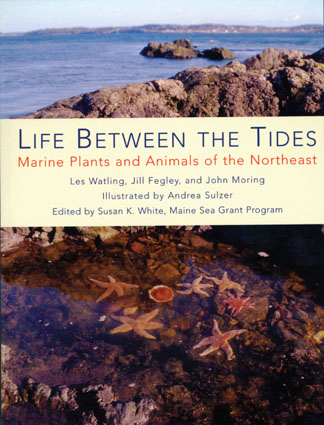 |
|
Life Between the Tides: Marine Plants
and Animals of the Northeast
By Les Watling, Jill Fegley and John Moring; illustrated by Andrea Sulzer. Tilbury House, Gardiner, Maine 1-800-582-1899
Reviewed by Lee Bumsted
When you walk along your favorite tidal shoreline, do you find yourself pausing to observe things in your path? A shell with an interesting shape, an odd bit of seaweed or a flowering plant might catch your eye? Do you stop to gaze into tide pools, marveling at the creatures moving about within them? If so, Life Between the Tides: Marine Plants and Animals of the Northeast will help you identify your finds. It will also help you appreciate the rich variety of life in the intertidal zone.
You can browse through this 6” x 8” field guide at home or slip it into your day pack when you head out. Its 110 pages are neatly organized to help you quickly locate the object of your interest and the index lists both common and scientific names. The pages are evenly divided between text and illustrations. Delicate and detailed line drawings by Andrea Sulzer appear adjacent to concise descriptions of the organisms. Most of the entries feature an illustration and sometimes two. Sand dollars and green sea urchins, for instance, are shown in their live and skeletal states. The only thing missing is a glossary.
Life Between the Tides opens with an overview of coastal habitats, that is, salt marshes, mudflats, sand flats, beaches and rocky shores. Les Watling, a professor of oceanography and marine biology at the University of Maine, contributed this introduction plus the extensive chapter on invertebrates that follows.
While varying greatly in appearance, most invertebrates have in common their dependence on moving water to bring them food. Some simple invertebrates are sponges, jellyfish and worms. There are shell-bearers such as mussels, clams, scallops and periwinkles. Arthropods with exoskeletons, including horseshoe crabs and lobsters, are invertebrates too. So are sea stars and sand dollars, echinoderms with a five-part symmetry to their bodies.
Some of the invertebrates carry marvelous common names, such as the ornate spaghetti worm or the bushy-backed sea slug. Watling explains the fascinating ways they feed. Speckled flatworms trap small animals in sticky slime, for instance, and bloodworms inject their prey with a neurotoxin. He also covers invertebrates' means of locomotion or attachment to other surfaces. Sea stars move using the tube feet on the underside of their five arms. Barnacles glue their “heads” to rocks.
A chapter on fish introduces a dozen common to the intertidal zone. Among them are the lumpfish, “a football with warts,” that uses a suction device to attach to marine algae. The American sand lance is a long thin fish that burrows in the sand of the surf zone. The Atlantic silverside prefers water less than two meters deep and can be seen schooling along sandy beaches. The grubby has an antifreeze element in its blood plasma and can thrive in cold, shallow waters. John Moring, a professor of zoology and marine sciences at the University of Maine who died before the book’s publication, authored this section.
Jill Fegley, an assistant professor of marine biology at Maine Maritime Academy, describes plants and seaweeds of the intertidal zone in the final chapter. Salt marsh plants and sea grasses have physical adaptations that allow them to tolerate high levels of salinity. They inhabit specific ranges between the highest and lowest tides. Flowering sea lavender and seaside plantain, for instance, can grow in salt pannes. These depressions in the marsh that retain seawater at low tide have particularly high concentrations of salt. Cordgrass is the tall grass that grows near the estuary, and salt meadow hay has a niche a bit inland of cordgrass.
The illustrations of the seaweeds highlight their beauty, and help make it clear that they are not true plants, but rather algae. Plants and seaweeds do have photosynthesis in common, but many other features differentiate them. One such feature in a complex seaweed is the holdfast, a structure that anchors it. Nutrients do not move up the holdfast, as they would in a plant's root, but rather are absorbed over the entire alga. Seaweed species occur at different intertidal and subtidal heights, depending on factors such as their light requirements. Green algae, including dead man's fingers and edible sea lettuce, require a lot of sunlight. Knotted wrack, a type of brown algae, is easy to spot because its air bladders make it buoyant. Kelp, which is also brown algae, is becoming easier to find as the sea urchins that feed on it are being commercially harvested. Red algae such as dulse and nori resides in low-light locations.
Life Between the Tides helps you understand the many ways marine organisms feed, move about or stay put and respire. It explains what niches they occupy and tells something of how they serve as refuge or food for other creatures. The next time you set out for a saltwater shoreline, carry this guide with you and take some time to observe the salt marshes, tide pools or beaches you find there. Perhaps you'll spot a bushy-backed sea slug! |

